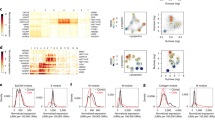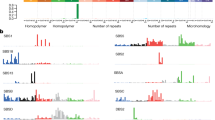Abstract
Little it known about human stem cells although they are likely to be the earliest progenitors of carcinomas. Just as methylation can substitute for mutations to inactivate tumor suppressor genes, methylation can also substitute for mutations in a phylogenetic analysis. This review explains why stem cell dynamics may be important to tumor progression and how methylation patterns found in a normal human colon can be used to reconstruct the behavior of crypt stem cells. Histories are recorded in sequences and strategies used to reconstruct phylogenies from sequences likely apply to methylation patterns because both exhibit somatic inheritance. Such a quantitative analysis of colon methylation patterns infers stem cells live in niches containing multiple ‘stem’ cells. Although niche stem cell numbers remain constant, clonal succession is inherent to niches because periodically progeny from a single stem cell become dominant. These niche succession cycles may potentially accumulate multiple alterations because they resemble superficially the clonal succession of tumor progression except that they occur invisibly in the absence of selection or phenotypic change. Alterations without immediate selective value may hitchhike passively in the stem cells that become dominant during niche succession cycles. The inherent ability of a niche to fix alterations (Muller's ratchet) is another potential mechanism besides instability and selection to sequentially accumulate multiple alterations. Many alterations found in colorectal tumors may reflect such occult clonal progression in normal colon.
This is a preview of subscription content, access via your institution
Access options
Subscribe to this journal
Receive 50 print issues and online access
$259.00 per year
only $5.18 per issue
Buy this article
- Purchase on Springer Link
- Instant access to full article PDF
Prices may be subject to local taxes which are calculated during checkout






Similar content being viewed by others
References
Ahuja N, Li Q, Mohan AL, Baylin SB, Issa JP . 1998 Cancer Res. 58: 5489–5494
Baker SJ, Markowitz S, Fearon ER, Willson JK, Vogelstein B . 1990 Science 249: 912–915
Bird RP . 1995 Cancer Lett. 93: 55–71
Booth C, Potten CS . 2000 J. Clin. Invest. 105: 1493–1499
Cairns J . 1975 Nature 255: 197–200
Campbell F, Williams GT, Appleton MA, Dixon MF, Harris M, Williams ED . 1996 Gut 39: 569–573
Chao L . 1990 Nature 348: 454–455
Chao L . 1997 Gene 205: 301–308
Charlesworth B . 1978 Proc. Natl. Acad. Sci. USA 75: 5618–5622
Cheng H, Bjerknes M, Amar J . 1984 Gastroenterology 86: 78–85
Clark SJ, Harrison J, Paul CL, Frommer M . 1994 Nucl. Acids Res. 22: 2990–2997
Clarke AR, Cummings MC, Harrison DJ . 1995 Oncogene 11: 1913–1920
Cross SH, Bird AP . 1995 Curr. Opin. Genet Dev. 5: 309–314
Donehower LA, Harvey M, Slagle BL, McArthur MJ, Montgomery Jr CA, Butel JS, Bradley A . 1992 Nature 356: 215–221
Fearon ER, Vogelstein B . 1990 Cell 61: 759–767
Felsenstein J . 1974 Genetics 78: 737–756
Foulds L . 1954 Cancer Res. 14: 327–339
Goyette MC, Cho K, Fasching CL, Levy DB, Kinzler KW, Paraskeva C, Vogelstein B, Stanbridge EJ . 1992 Mol. Cell. Biol. 12: 1387–1395
Groden J, Thliveris A, Samowitz W, Carlson M, Gelbert L, Albertsen H, Joslyn G, Stevens J, Spirio L, Robertson M, Sargeant L, Krapcho K, Wolff E, Burt R, Hughes JP, Warrington J, McPherson J, Wasmuth J, Le Paslier D, Abderrahim H, Cohen D, Leppert M, White R . 1991 Cell 66: 589–600
Hahn WC, Counter CM, Lundberg AS, Beijersbergen RL, Brooks MW, Weinberg RA . 1999 Nature 400: 464–468
Hanahan D, Weinberg RA . 2000 Cell 100: 57–70
Issa JP . 2000 Curr. Top. Microbiol. Immunol. 249: 101–118
Jones PA, Laird PW . 1999 Nat. Genet. 21: 163–167
Kinzler KW, Vogelstein B . 1996 Cell 87: 159–170
Loeb LA . 1991 Cancer Res. 51: 3075–3079
Malkin D, Li FP, Strong LC, Fraumeni Jr JF, Nelson CE, Kim DH, Kassel J, Gryka MA, Bischoff FZ, Tainsky MA, Friend SH . 1990 Science 250: 1233–1238
Muller HJ . 1964 Mutat. Res. 1: 2–9
Nowell PC . 1976 Science 194: 23–28
Oshima M, Oshima H, Taketo MM . 1996 Dev. Biol. 179: 297–302
Park HS, Goodlad RA, Wright NA . 1995 Am. J. Pathol. 147: 1416–1427
Parsons R, Li GM, Longley M, Modrich P, Liu B, Berk T, Hamilton SR, Kinzler KW, Vogelstein B . 1995 Science 268: 738–740
Pearson H . 2002 Nature 415: 8–9
Pfeifer GP, Steigerwald SD, Hansen RS, Gartler SM, Riggs AD . 1990 Proc. Natl. Acad. Sci. USA 87: 8252–8256
Potten CS, Loeffler M . 1990 Development 110: 1001–1020
Potten CS, Kellett M, Roberts SA, Rew DA, Wilson GD . 1992 Gut 33: 71–78
Reik W, Dean W, Walter J . 2001 Science 293: 1089–1093
Ro S, Rannala B . 2001 Proc. Natl. Acad. Sci. USA 98: 10519–10521
Shmookler Reis RJ, Goldstein S . 1982 Proc. Natl. Acad. Sci. USA 79: 3949–3953
Shoemaker AR, Haigis KM, Baker SM, Dudley S, Liskay RM, Dove WF . 2000 Oncogene 19: 2774–2779
Smith JM, Nee S . 1990 Nature 348: 391–392
Spradling A, Drummond-Barbosa D, Kai T . 2001 Nature 414: 98–104
Tanaka K, Oshimura M, Kikuchi R, Seki M, Hayashi T, Miyaki M . 1991 Nature 349: 340–342
Tomlinson IP, Novelli MR, Bodmer WF . 1996 Proc. Natl. Acad. Sci. USA 93: 14800–14803
Turker MS, Bestor TH . 1997 Mutat. Res. 386: 119–130
Watt FM, Hogan BL . 2000 Science 287: 1427–1430
Wigler M, Levy D, Perucho M . 1981 Cell 24: 33–40
Williams ED, Lowes AP, Williams D, Williams GT . 1992 Am. J. Pathol. 141: 773–776
Yatabe Y, Tavare S, Shibata D . 2001 Proc. Natl. Acad. Sci. USA 98: 10839–10844
Acknowledgements
Supported by Grant DK61140 from the National Institute of Diabetes and Digestive and Kidney Disease and a postdoctoral fellowship from the Korea Science & Engineering Foundation.
Author information
Authors and Affiliations
Corresponding author
Rights and permissions
About this article
Cite this article
Kim, KM., Shibata, D. Methylation reveals a niche: stem cell succession in human colon crypts. Oncogene 21, 5441–5449 (2002). https://doi.org/10.1038/sj.onc.1205604
Published:
Issue Date:
DOI: https://doi.org/10.1038/sj.onc.1205604
Keywords
This article is cited by
-
Longitudinal analysis of colon crypt stem cell dynamics in sulindac treated Familial Adenomatous Polyposis patients
Scientific Reports (2017)
-
Stem cell dynamics and pretumor progression in the intestinal tract
Journal of Gastroenterology (2016)
-
Single-cell sequencing-based technologies will revolutionize whole-organism science
Nature Reviews Genetics (2013)
-
Deficient expression of DNA repair enzymes in early progression to sporadic colon cancer
Genome Integrity (2012)
-
Drosophilamidgut homeostasis involves neutral competition between symmetrically dividing intestinal stem cells
The EMBO Journal (2012)



